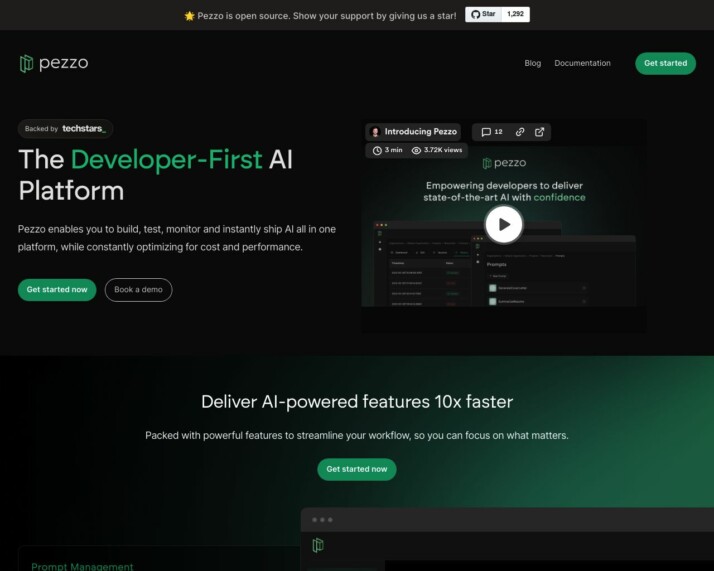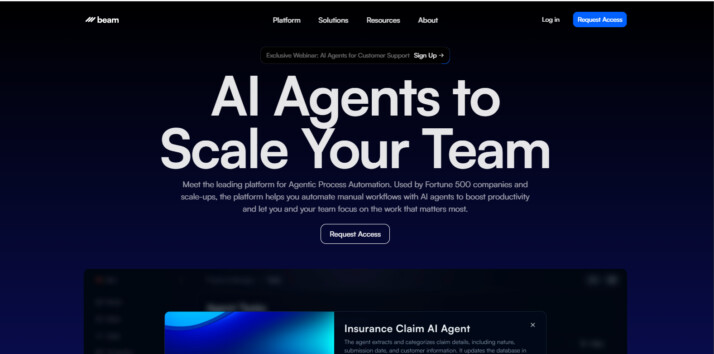Pezzo vs. Beam AI: Strengths and Limitations in AI Development
AI development platforms Pezzo vs. Beam AI offer unique approaches to harnessing artificial intelligence, but each comes with limitations. Pezzo shines in prompt management and optimization, while Beam AI focuses on generative agents for task automation. However, both platforms lack essential features found in more comprehensive solutions. This comparison explores the strengths and weaknesses of Pezzo and Beam AI, highlighting how SmythOS addresses their shortcomings. We’ll examine key features, use cases, and overall value to help you make an informed decision for your AI development needs. Whether you’re a seasoned developer or a business leader seeking to leverage AI, this analysis provides crucial insights into choosing the right platform for your projects.
Pezzo Overview
Pezzo revolutionizes AI development with its open-source toolkit designed for efficiency and collaboration. The platform streamlines prompt design, management, and publishing, empowering developers to deliver AI solutions faster.


Screenshot of Pezzo website
Pezzo’s standout feature is its effortless prompt and version management system. This tool allows developers to handle multiple AI prompts and versions seamlessly, significantly accelerating the development process. For teams working on complex AI projects, this capability proves invaluable in maintaining consistency and tracking changes.
Pezzo’s standout feature is its effortless prompt and version management system. This tool allows developers to handle multiple AI prompts and versions seamlessly, significantly accelerating the development process.
The platform also offers powerful conversion-boosting tools through A/B testing, targeting, and experiments. These features enable developers to optimize their AI models’ performance and improve conversion rates. Additionally, Pezzo provides cost optimization tools that can potentially save up to 50% on AI operations, a critical factor for businesses managing their AI budgets.
Pezzo’s comprehensive troubleshooting capabilities set it apart from competitors. The platform offers detailed execution history, time-travel debugging, and test suites, allowing developers to deploy AI models with confidence. This level of insight significantly reduces debugging time and helps teams pinpoint issues quickly and efficiently.
While Pezzo excels in many areas, it lacks some features found in more comprehensive AI development platforms. The absence of a visual builder or no-code editor may limit its accessibility for non-technical users. Additionally, Pezzo does not offer specific features for autonomous agents or multi-agent collaboration, which might be essential for certain advanced AI projects.
Beam AI Overview
Beam AI specializes in developing generative AI agents that automate repetitive manual tasks for organizations. Their Agentic Process Automations (APAs) perform tasks like data extraction, customer inquiry management, and order optimization faster and more cost-effectively than human workers.


Beam AI Website Screenshot
Beam AI’s agents excel in back-office automation, customer service, compliance, and order processing. These AI-powered solutions adapt and improve over time, continuously enhancing precision and efficiency. The platform integrates seamlessly with existing internal systems, enabling comprehensive workflow automation.
Beam AI’s agents excel in back-office automation, customer service, compliance, and order processing. These AI-powered solutions adapt and improve over time, continuously enhancing precision and efficiency.
While Beam AI offers powerful automation capabilities, it lacks some features found in more comprehensive platforms. The absence of a visual builder or no-code editor may limit accessibility for non-technical users. Additionally, Beam AI doesn’t provide multimodal AI capabilities or support for various file types, potentially restricting its versatility in handling diverse data formats.
Beam AI emphasizes sustainability and speed in its approach to AI development. The company’s international team works towards a future driven by artificial general intelligence (AGI), reflecting their commitment to pushing the boundaries of AI technology. However, the platform’s focus on specific use cases may not suit organizations seeking a more versatile, all-in-one AI development solution.
For businesses primarily concerned with automating repetitive tasks and improving operational efficiency, Beam AI presents a compelling option. Yet, those requiring a broader range of AI development tools or extensive customization options might find the platform’s offerings somewhat limited compared to more comprehensive solutions in the market.
Feature Comparison
Pezzo and Beam AI offer distinct approaches to AI development, each with its own strengths and limitations. Pezzo excels in prompt management and optimization, providing developers with powerful tools for version control, A/B testing, and cost optimization. Its detailed execution history and debugging capabilities give teams unprecedented insight into their AI operations. However, Pezzo lacks some key features found in more comprehensive platforms. It doesn’t offer a visual builder or no-code editor, potentially limiting accessibility for non-technical users. Additionally, Pezzo doesn’t provide specific features for autonomous agents or multi-agent collaboration, which may be crucial for advanced AI projects.
Beam AI, on the other hand, focuses on developing generative AI agents for task automation. Its Agentic Process Automations (APAs) excel in back-office tasks, customer service, and order processing. Beam AI’s agents adapt and improve over time, enhancing efficiency. However, like Pezzo, Beam AI lacks a visual builder and no-code editor. It also doesn’t offer multimodal AI capabilities or support for various file types, which may limit its versatility in handling diverse data formats.
Both platforms have gaps in core components and security features compared to more comprehensive solutions. Neither offers constrained alignment tools, data encryption, or OAuth support. They also lack advanced features like hosted vector databases, sitemap crawlers, and support for various file types. These limitations may impact their suitability for organizations requiring robust security measures or diverse data handling capabilities.
Feature Comparison Table
| Pezzo | Beam AI | SmythOS | |
|---|---|---|---|
| CORE FEATURES | |||
| Hosted Agents (Dev, Production) | ❌ | ✅ | ✅ |
| Visual Builder | ❌ | ❌ | ✅ |
| No-Code Options | ❌ | ❌ | ✅ |
| Memory & Context | ❌ | ✅ | ✅ |
| Autonomous Agents | ❌ | ✅ | ✅ |
| Debug Tools | ✅ | ❌ | ✅ |
| Multimodal | ✅ | ❌ | ✅ |
| SECURITY | |||
| Constrained Alignment | ❌ | ✅ | ✅ |
| IP Control | ❌ | ✅ | ✅ |
| COMPONENTS | |||
| Data Lakes | ❌ | ❌ | ✅ |
| DEPLOYMENT OPTIONS (EMBODIMENTS) | |||
| Deploy as Scheduled Agent | ❌ | ✅ | ✅ |
| DATA LAKE SUPPORT | |||
| Hosted Vector Database | ❌ | ❌ | ✅ |
| Sitemap Crawler | ❌ | ❌ | ✅ |
| YouTube Transcript Crawler | ❌ | ❌ | ✅ |
| URL Crawler | ✅ | ❌ | ✅ |
Best Alternative to Pezzo and Beam AI
SmythOS emerges as the superior alternative to Pezzo and Beam AI, offering a comprehensive platform for AI agent development and deployment. We’ve designed SmythOS to address the limitations of other platforms while providing a robust set of features that cater to a wide range of users and use cases.
Our visual builder sets SmythOS apart from both Pezzo and Beam AI. Unlike these competitors, we offer an intuitive drag-and-drop interface that allows users to create complex AI workflows without extensive coding knowledge. This feature democratizes AI development, making it accessible to technical and non-technical users alike.
SmythOS excels in its extensive feature set, surpassing both Pezzo and Beam AI in critical areas. We provide support for hosted agents in both development and production environments, ensuring seamless scalability as projects grow.
SmythOS excels in its extensive feature set, surpassing both Pezzo and Beam AI in critical areas. We provide support for hosted agents in both development and production environments, ensuring seamless scalability as projects grow. Our platform also offers advanced memory and context management, allowing AI agents to maintain coherent conversations and learn from past interactions. These capabilities are essential for creating sophisticated AI solutions that Pezzo and Beam AI may struggle to match.
Unlike our competitors, SmythOS supports a wide array of deployment options and integrations. We enable users to deploy AI agents as APIs, webhooks, site chats, and even scheduled agents. This versatility allows for seamless integration with existing systems and workflows, a crucial factor that sets us apart from Pezzo and Beam AI. Additionally, our platform supports various data types and sources, including PDFs, Word documents, and web crawlers, providing unparalleled flexibility in handling diverse information.
In terms of security and scalability, SmythOS offers features that Pezzo and Beam AI lack. We provide robust data encryption, OAuth support, and IP control, ensuring that your AI agents operate in a secure environment. Our platform also includes a hosted vector database, enabling efficient handling of large-scale data operations. These enterprise-grade features make SmythOS the ideal choice for businesses of all sizes, from startups to large corporations, looking for a reliable and scalable AI solution.
Conclusion
Pezzo and Beam AI offer unique approaches to AI development, each with distinct strengths. Pezzo excels in prompt management and optimization, providing developers with powerful tools for version control and debugging. Beam AI focuses on generative AI agents for task automation, particularly in back-office operations and customer service. Both platforms deliver value in their specific domains, but they lack some features found in more comprehensive solutions.
SmythOS stands out as the superior choice, offering a broader range of capabilities that address the limitations of both Pezzo and Beam AI. Our platform provides a visual builder and no-code editor, making AI development accessible to both technical and non-technical users. We support multimodal AI, various file types, and offer robust security features including data encryption and OAuth support.
Unlike Pezzo and Beam AI, SmythOS enables true multi-agent collaboration and autonomous agent deployment. Our platform’s versatility shines through its support for over 300,000 integrations, allowing users to create complex AI workflows effortlessly. Whether you need to deploy as an API, chatbot, or scheduled agent, SmythOS offers the flexibility to meet diverse business needs.
Experience the future of AI development with SmythOS. Create a free account today and discover how our comprehensive platform can revolutionize your AI projects. With our intuitive interface, extensive integration options, and powerful deployment capabilities, you’ll be able to build and deploy AI agents anywhere in record time. Don’t just adapt to the AI revolution – lead it with SmythOS.
Last updated:
Disclaimer: The information presented in this article is for general informational purposes only and is provided as is. While we strive to keep the content up-to-date and accurate, we make no representations or warranties of any kind, express or implied, about the completeness, accuracy, reliability, suitability, or availability of the information contained in this article.
Any reliance you place on such information is strictly at your own risk. We reserve the right to make additions, deletions, or modifications to the contents of this article at any time without prior notice.
In no event will we be liable for any loss or damage including without limitation, indirect or consequential loss or damage, or any loss or damage whatsoever arising from loss of data, profits, or any other loss not specified herein arising out of, or in connection with, the use of this article.
Despite our best efforts, this article may contain oversights, errors, or omissions. If you notice any inaccuracies or have concerns about the content, please report them through our content feedback form. Your input helps us maintain the quality and reliability of our information.
